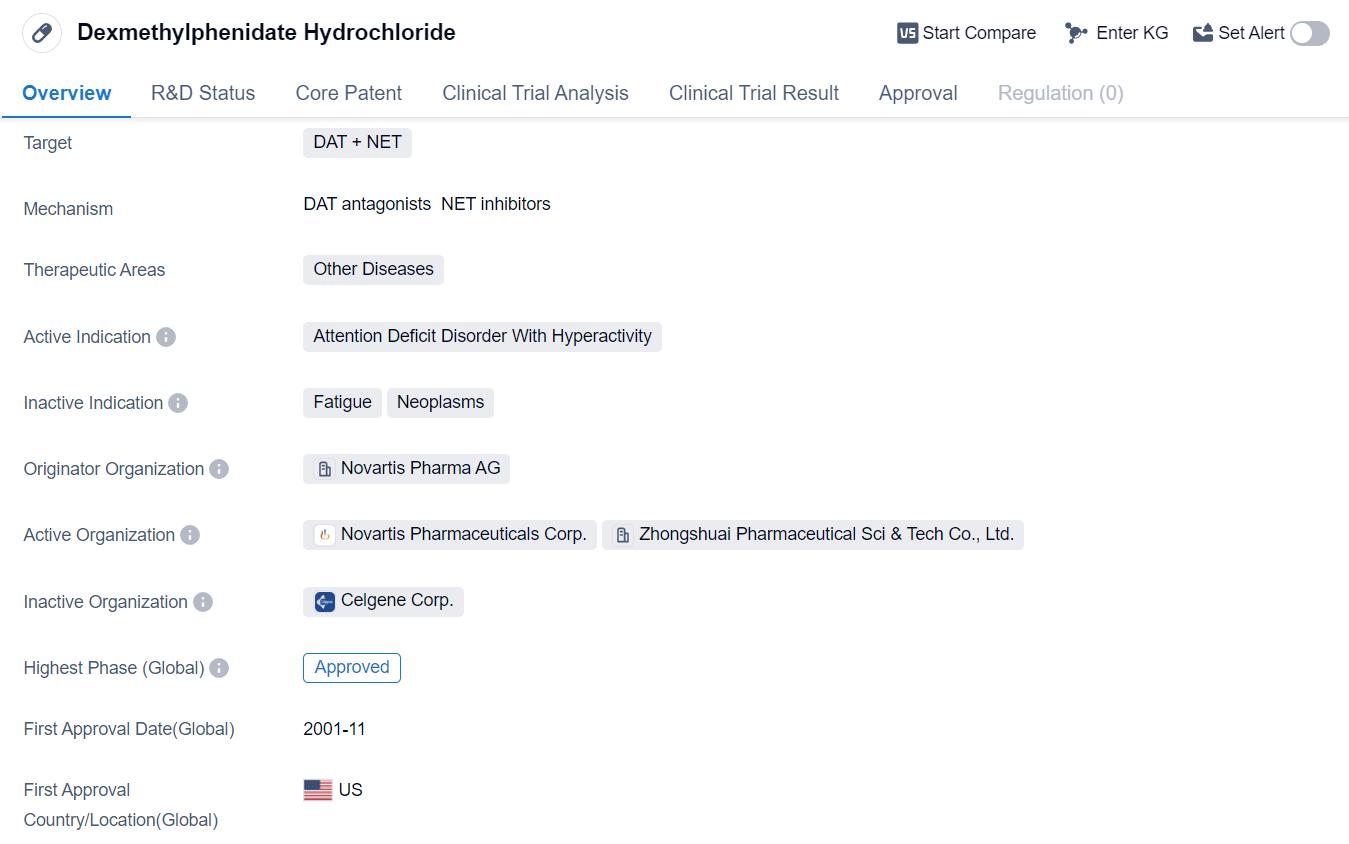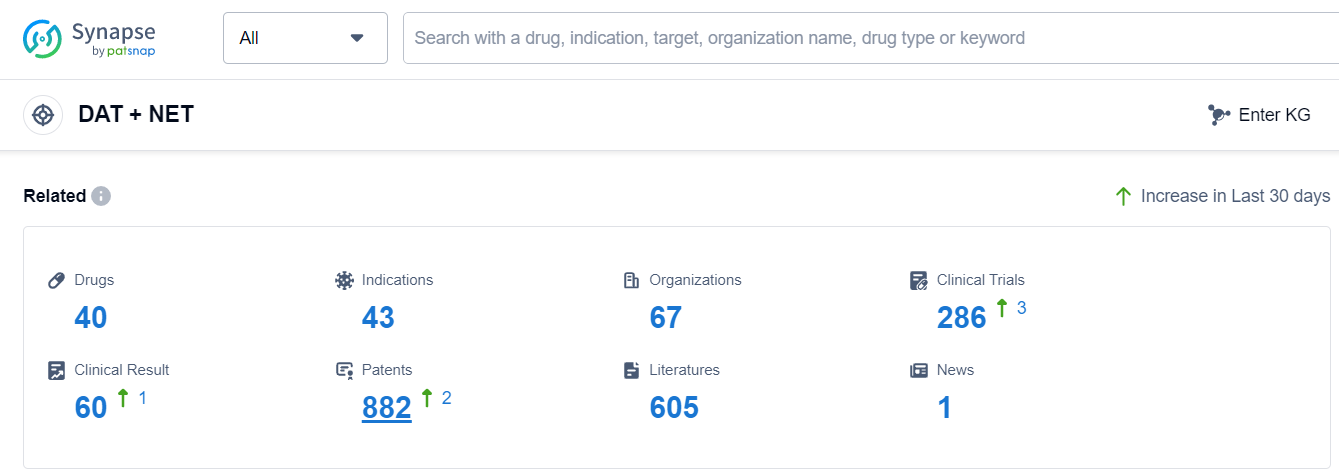Dexmethylphenidate Hydrochloride Unveiled: A Detailed Overview of its Revolutionary R&D Breakthroughs
Dexmethylphenidate Hydrochloride's R&D Progress
Dexmethylphenidate Hydrochloride is a small molecule drug that falls under the therapeutic area of Other Diseases in the field of biomedicine. It is primarily used for the treatment of Attention Deficit Disorder with Hyperactivity (ADHD). The drug targets the dopamine transporter (DAT) and norepinephrine transporter (NET) in the central nervous system.
The originator organization of Dexmethylphenidate Hydrochloride is Novartis Pharma AG, a renowned pharmaceutical company. The drug has reached the highest phase of development which is approved globally. It received its first approval in the United States in November 2001.
Dexmethylphenidate Hydrochloride has shown promising results in clinical trials, leading to its approval for the treatment of ADHD. It is commonly prescribed to children and adults diagnosed with this disorder to help improve their attention span, reduce impulsiveness, and control hyperactivity.
The drug's mechanism of action involves inhibiting the reuptake of dopamine and norepinephrine, which are neurotransmitters involved in regulating attention and behavior. By increasing the levels of these neurotransmitters in the brain, Dexmethylphenidate Hydrochloride helps restore the balance and improve ADHD symptoms.
The approval of Dexmethylphenidate Hydrochloride in 2001 marked a significant milestone in the treatment of ADHD, providing healthcare professionals with an effective medication option. It has since become a widely prescribed drug for individuals with ADHD, helping them manage their symptoms and improve their quality of life.
👇Please click on the image below to directly access the latest data (R&D Status | Core Patent | Clinical Trial | Approval status in Global countries) of this drug.
Mechanism of Action for Dexmethylphenidate Hydrochloride: DAT antagonist and NET inhibitor
DAT antagonists and NET inhibitors are both types of drugs that affect the reuptake of neurotransmitters in the brain.
1. DAT antagonists: These drugs target the dopamine transporter (DAT), which is responsible for removing dopamine from the synaptic cleft, the space between neurons. By inhibiting DAT, these drugs increase the concentration of dopamine in the synaptic cleft, leading to enhanced dopamine signaling. This can have various effects on the brain, including increased motivation, improved mood, and heightened alertness. DAT antagonists are commonly used in the treatment of attention deficit hyperactivity disorder (ADHD) and certain types of depression.
2. NET inhibitors: NET stands for norepinephrine transporter, and NET inhibitors specifically target this transporter. The norepinephrine transporter is responsible for reuptake of norepinephrine, a neurotransmitter involved in regulating mood, attention, and stress response. By inhibiting NET, these drugs increase the levels of norepinephrine in the synaptic cleft, leading to enhanced norepinephrine signaling. This can result in increased alertness, improved focus, and elevated mood. NET inhibitors are used in the treatment of conditions such as depression, anxiety disorders, and attention deficit disorder.
Both DAT antagonists and NET inhibitors are examples of drugs that modulate neurotransmitter levels in the brain, and they can have significant effects on brain function and behavior.
Drug Target R&D Trends for Dexmethylphenidate Hydrochloride
Based on the analysis of the provided data, the current competitive landscape of target DAT + NET is characterized by companies with diverse R&D pipelines and drugs in various stages of development. The highest stage of development is the "Approved" phase, indicating successful drug development in this target area. The indications for the approved drugs cover a wide range of conditions, including attention deficit disorder, depressive disorder, obesity, narcolepsy, and anxiety. The most rapidly progressing drug types are small molecule drugs and unknown drugs. The countries/locations with the fastest development include the United States, European Union, China, Canada, and several others. Overall, the target DAT + NET shows promising growth potential in the pharmaceutical industry.
According to Patsnap Synapse, as of 13 Sep 2023, there are a total of 40 DAT + NET drugs worldwide, from 67 organizations, covering 43 indications, and conducting 286 clinical trials.
Please click on the picture link below for free registration or log in directly if you have a freemium account, you can browse the latest research progress on drugs, indications, organizations, clinical trials, clinical results, and drug patents related to this target
Conclusion
In summary, Dexmethylphenidate Hydrochloride is a small molecule drug developed by Novartis Pharma AG. It is approved globally for the treatment of Attention Deficit Disorder with Hyperactivity. By targeting the dopamine and norepinephrine transporters, the drug helps improve attention span, reduce impulsiveness, and control hyperactivity in individuals with ADHD. Its approval in 2001 has made it a valuable medication option for patients diagnosed with this disorder.






